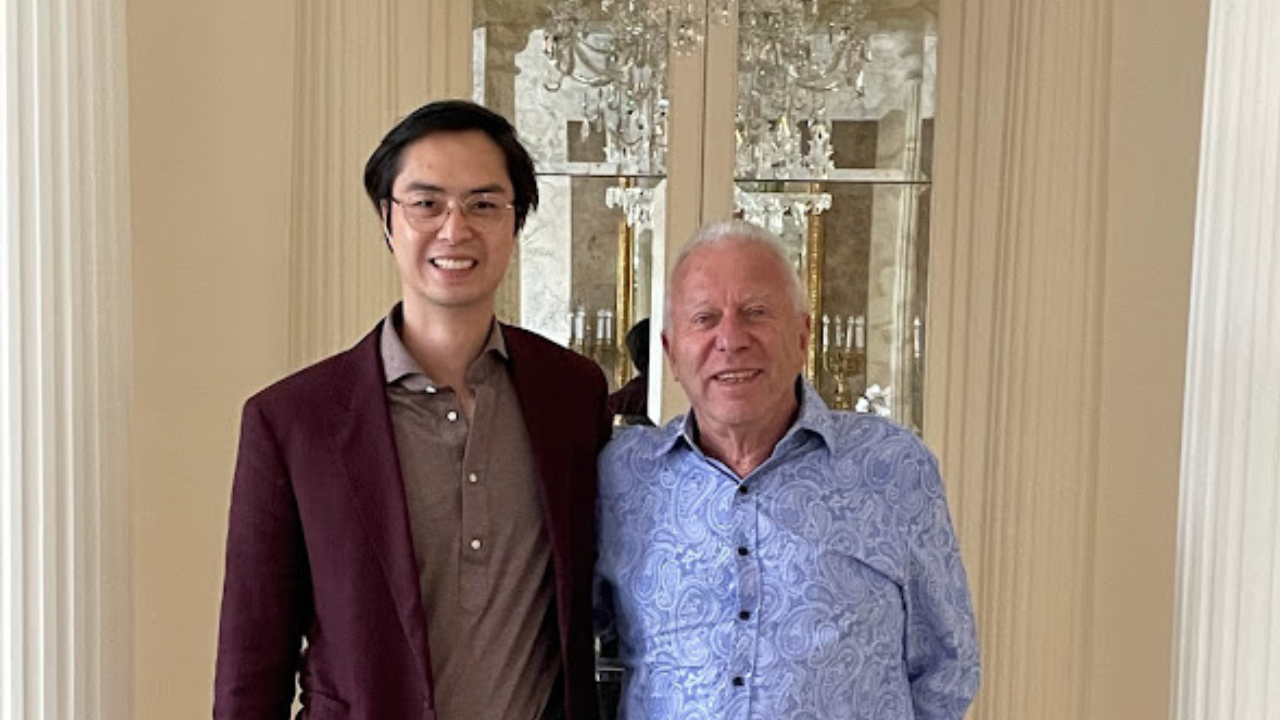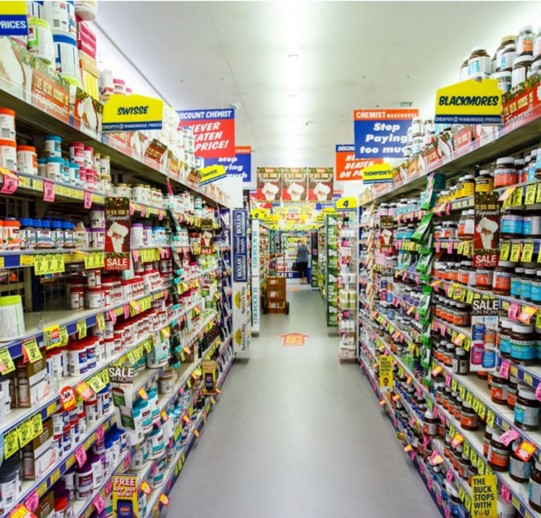Founder Interview: Lessons from the founder of Chemist Warehouse (Part 2)
In Part 1 we detailed how Jack Gance and his brother, Sam, built the sunglass and cosmetics distributor Le Specs before selling the business in 1990. The Le Specs business was originally launched as a pharmacist-to-pharmacist wholesaler, and Jack and his brother Sam were themselves qualified pharmacists with their own established pharmacies.
Separate to the Le Specs business, Jack was concurrently cultivating a footprint of pharmacies in Victoria which grew from 2 to 35 through a series of partnerships. This chain of stores would eventually be branded as the MyChemist. It would be the first iteration of what would spark the creation of Chemist Warehouse – the second phase of Jack’s career and his biggest success. It would become a pharmacy brand that would dominate the Australian market.

Jack Gance (right) with author Lawrence Lam
CREATING NEW OPPORTUNITIES IN CROWDED MARKETS
Prior to Chemist Warehouse, the pharmacy market in Australia was fragmented and traditionally hard to scale due to strict regulations and the requirement to have qualified pharmacists on premises. That was until Jack changed the business model.
Traditionally, the local chemist was a member of the community, just like the local doctor. Roughly 70% of revenues of the average pharmacy store were from prescription drugs, and the remaining 30% being from non-prescription drugs and other health-related products.
The Chemist Warehouse model flips this script. Most sales are from non-prescription drugs such as vitamins, fragrances, cosmetics, skincare, and natural medicines. This segment, often referred to as the ‘front-of-shop’ sales, accounts for approximately 70% of revenues, whereas prescription medicines (behind-the-counter) are 30% of revenues. Readers should not misinterpret Chemist Warehouse as generating less prescription sales, but rather it sells far more front-of-shop products than the average pharmacy in Australia. Prescription sales remain on par, if not more, than the average pharmacy.
Chemist Warehouse’s growth comes from the ability to create a new market within an established industry. It does this by increasing the floorspace allocated to front-of-shop products, flipping the traditional drug-focused pharmacy model into a warehouse focused on showcasing all the non-prescription products. Jack’s retail philosophy centres around bombarding customers with such a wide variety of products that they will eventually find something that they want. “If you walk into a shop looking for a tie and the shop has three ties, you might not buy one. But if the shop has 1,000 ties, you’re more likely to find one or more that suit you”, Jack says.

“If you walk into a shop looking for a tie and the shop has three ties, you might not buy one. But if the shop has 1,000 ties, you’re more likely to find one or more that suit you” – Jack Gance
This philosophy also gives the ability to cross-sell more products. Like the Costco model, customers of Chemist Warehouse often walk out buying more than they intended simply because of the overwhelming product range and overt signage which serves as a reminder of all the forgotten shopping list items. On average, the revenue of a Chemist Warehouse store is roughly four to six times that of an average pharmacy store due to the velocity at which they turn over stock. This brings scale and buying power from suppliers which in turn enables low pricing for customers.
From an investment perspective, Chemist Warehouse is akin to a platform business. It’s reputation as the preeminent low-cost pharmacy brand means consumers will gravitate to their shops. They match these consumers with vendors selling cosmetics, vitamins, skincare, and health products. Their ‘platform’ is the network of 500 stores that give them the footprint to be the country’s number one pharmacy retailer.
The physical store network is connected by unified sales systems and inventory management systems which allow head office a centralised view of the platform. Like most platform businesses, they have self-perpetuating monopolistic characteristics as buyers and sellers reinforce the need to transact through Chemist Warehouse. Ultimately this creates scale and reduces inventory risk for Jack’s business. The more they sell, the lower the prices they can offer, and the more customers they win.
A FOUNDER’S CONNECTION TO THEIR BUSINESS
Many pharmacy retailers have attempted to create a national chain though none have dominated the market like Chemist Warehouse.
From the outset of my interview with Jack, it’s abundantly clear he retains intimate knowledge of the business despite much of the daily operations now being run by his team of 500 at head office. He cites store sales figures from the prior week and tells me which products are trending in his stores. He receives daily reports from the centralised sales and inventory management systems.
What he detests are business leaders detached from their customers. Jack tells me about a conversation he had with the CEO of a leading Australian health company selling a significant amount of product to Chemist Warehouse. Jack asked the freshly appointed CEO, a non-founder, if he knew the name of Chemist Warehouse’s representative buyer – the key influencer who determines which products Chemist Warehouse will buy and in what quantity. The CEO was not able to. Jack asked if the CEO knew the buyer’s name from one of Australia’s largest supermarkets, another key client. “Jack, I know the CEO of the supermarket chain, but I don’t know the buyer by name. I’m a CEO of a multinational business, I have thousands of clients and it’s impossible for me to know every buyer by name”, he said.
But that is the essence of why founder-led businesses are different. As Jack points out, both Chemist Warehouse and the supermarket chain represent a significant portion of this company’s revenues. In his view, a CEO must foster a close relationship with those individuals at the heart of the decision-making process of their customers.
IN SEARCH OF THE NEXT JACK GANCE
Jack is cautiously aggressive when it comes to business. An example is Chemist Warehouse’s expansion into the New Zealand and Ireland. “Many companies have failed with big overseas expansion plans,” he tells me, reeling off names of Australian companies that have expanded too fast overseas. Although the eventual plan is to expand into the United Kingdom, Chemist Warehouse has opted to test the market in nearby Ireland first by piloting a small number of stores.
“I don’t assume I know more than the local market,” Jack emphasises. He looks to form partnerships with local operators to minimise the learning curve and expansion costs.
Like many founder-led companies, Jack runs Chemist Warehouse with very little debt. The focus has been on positive cashflow generation and long-term financial stability, an awareness he gained from his Le Specs days which was an operation hungry for working capital.
He favours organic growth over large acquisitions. In 2017, Chemist Warehouse expanded into New Zealand with its first stores initially funded with $5 million of starting capital. New Zealand, with its less stringent regulatory framework compared to Australia, has proven a fertile ground for Chemist Warehouse’s expansion. Aside from the initial capital, the expansion has not required additional investment – the new stores continue to be self-funded by revenues from existing New Zealand stores.
With organic opportunities in abundance, very few acquisitions make sense to Jack. Like most long-term minded founders, that is exactly the way he prefers.
Jack’s style errs on self-reliance rather than outsourcing. Early on he chose to run his own centralised sales software system on Chemist Warehouse’s cash registers to centralise the sales data. The vertically integrated model is a core strategic advantage of the business. It gives head office granular visibility over the entire store network and standardises the technology infrastructure, enabling efficiency when rolling out new stores and products.
A LESSON ON RISK TAKING
Jack believes true entrepreneurs are risk mitigators. He did this with the marketing deal he struck to launch Le Specs, paying no upfront costs, and instead sharing a percentage of subsequent profits, thereby reducing the expenditure outlayed in case the venture was unsuccessful. And Chemist Warehouse’s cautiously aggressive UK expansion plan has Jack’s risk management philosophy written all over it.
Though a success story, Jack has experienced his share of failures. After he sold Le Specs, Jack remained in management for two years, working with the new owner during the transition. He watched Le Tan decline under new ownership as he lost the decision-making power to reverse the trend. He attributes the experience as a lesson in the importance of maintaining good relationships with suppliers, not just customers. When the new owner took over, suppliers were strong-armed into renegotiating contracts with unfavourable terms for them. This proved successful for Le Tan in the short-term but eroded the quality of the product as relationships later deteriorated.
COMPANIES THAT LOCALISE AN ALREADY PROVEN GLOBAL MODEL
Smaller niche markets may appear less appealing to investors, but even in the sunglasses and pharmacy market in a relatively small country like Australia, Jack Gance has managed to create significant value. The conventional view teaches investors to focus on markets with a large Total Addressable Market (“TAM”), but with larger TAM comes greater attention and increased competition. Instead, investors may find opportunity in companies that localise products and services that have already been proven to work overseas.
For instance, Le Specs introduced a tougher, more flexible sunglass range that was first manufactured and sold in France. Jack localised it for the Australian market after his wife Evelynne visited a trade show in France.
Similarly, he describes how the idea of Chemist Warehouse came about after having visited the “busy, in-you-face, warehouse-style” pharmacies in the US during the 1970s.
The localisation strategy epitomises Jack’s focus on risk minimisation; adapting a proven model overseas is much less risky than creating an untested one.
***
Part 1 of this feature was published last week
2 topics

